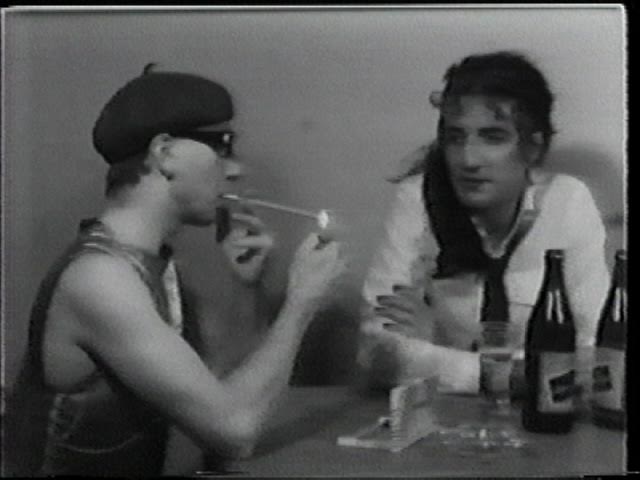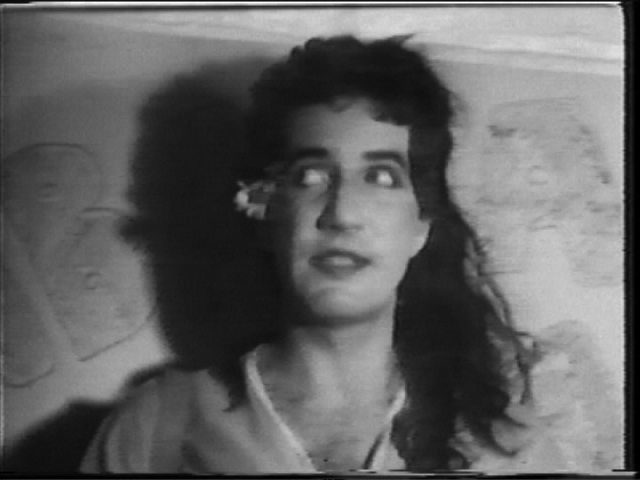Francisco-Fernando Granados
To engage with the relationship between queerness and visuality is to speak of a particular sense. A sense that, while particular, is not always fully explainable in the present tense. Something of this particularly elusive queer sensibility pervades the work of artist Colin Campbell. Born in Manitoba in 1942 and based out of Toronto for most of his acclaimed career until his passing in 2001, Campbell was among those at the vanguard of video art in Canada since the early 1970s. The establishment of video within experimental art circles in North America coincided with the rise of a politics of visibility that accompanied movements for social liberation women, Black and other racialized communities and for so-called ‘sexual minorities.’ My exploration of Campbell’s oeuvre will focus on work from that period of time between the Stonewall Riots and the crashing dawn of the AIDS crisis. Within this time, Campbell took up aesthetic strategies ranging from conceptualism to pop culture appropriation to create moving images that playfully circumvent any stable sense of identity. Instead, works like True / False, Modern Love, Bad Girls and He’s a Growing Boy, She’s Turning Forty lay bare the constructs and fictions that underpin the images that flash across the video screen, while creating a series of seductive scenes that combine a dexterous and thoughtful eye for composition with an intuitive sensibility that opens up the work to that which exists outside its frame. The queerness of Campbell’s work is one that makes strange that which the viewer sees. These scenes of seduction are sometimes self-centred, sometimes transgressive of gender norms and sometimes homoerotic, but they are persistently queer insofar as there is ‘something’ in them that escapes from them, escaping the viewer and returning to the work, time and time again. The openness in Campbell’s work allows it to speak with poignancy to the immediate context of the scenes he frames. As it becomes exposed to time, the scene becomes extended and points towards something that is found in a different temporal context from its original setting. That which escapes is what makes these scenes linger in the imagination, particularly now as the dialogue around HIV in North America shifts from crisis to management and queer bodies find themselves policed in new ways. But the extended scene in the Campbell’s work also points towards an incalculable queer future.

Colin Campbell, True / False, 1972, Video, 9:00 minutes.
Colin Campbell began his work in video in the early 1970s in the form of solo, non-narrative, single-shot performances for the camera. In these process-based works, the artist focuses on the distance between the viewer and the image of his body on the surface of the screen. In True / False from 1972, he faces the camera as he makes a series of potentially compromising statements that he then goes on to both confirm and deny:
‘I am an exhibitionist… true… false… I am seeing a psychiatrist… true… false… I am part Jewish… true… false… I am heterosexual… true… false…’
This conceptual action playfully pivots between fact and fiction, calling into question the truthfulness of the scene he frames for the viewer. Borrowing the notion of ‘framing the framer’ from artist, filmmaker and writer Trinh T. Minh-ha, Judith Butler suggests that ‘to call a frame into question is to show that the frame never quite contained the scene it was meant to limn, that something was already outside which made the very sense of the inside possible.’[1] According to Butler, the act of making visible the underpinnings of a given frame performs an ethics that produces a new context that continuously breaks with itself as a means to remain critical. By refusing to confirm or reject any of his statements, Campbell shows that the frame cannot hold any definitive assertion with regard to the intimate details of his life. In this way, Campbell performs a symmetrical doing and undoing of identification that gets closer and then further away from a confession. This symmetrical pivoting in the representation of the artist’s personality brings a figure into focus to then blur it again, making it strange, leaving something out, and producing a sense that manages to circumvent a clear identification.
But what is it that is outside of Campbell’s frame? Video as a medium is characterized by the temporal division that separates the moment of the action’s recording from the moments of its viewing. Campbell seems to acknowledge that time, which is the element that makes the sense of the scene possible, is precisely what escapes from the scene. Video is, after all, by definition, a time-based medium. The passage of time makes absolute knowledge impossible. ‘Is he or isn’t he? Was he at the time or was he ever?’ Campbell instead chooses to embrace an open-ended possibility. His resistance to create a scene of confession seems to recognize, with and without knowing it, that there is no way of guaranteeing the truthfulness or falsehood of any of his statements every time the video reaches its audience, and that the video reaches its audience in the tense of a continuous future that has gone on after his passing.

Colin Campbell, Modern Love, 1978, Video, 90:00 minutes.
As the decade went by, Campbell’s videos abandoned conceptualism and began to joyously borrow from movies, television and other pop culture sources. This move shaped his tapes into a series of richly layered, long-form narratives with multiple characters and storylines. Something of the Zeitgeist of the many sexual revolutions of the second half of the twentieth century is apparent as Campbell incorporated storytelling as an approach. As Randy Gledhill notes, ‘sexual definitions as we know them don’t apply’ in the artist’s video world.[2] In works like Modern Love from 1978, and Bad Girls from 1980 the artist still appears on camera, this time fully in character as Robin, a photocopy machine operator that falls in love with a party-loving show business type and rises to the ranks of hip Toronto rock stardom only to loose it all by the end of the multi-episode saga. Playing characters with gusto, with assorted masculine and feminine attributes, Campbell’s playfulness with gender roles suggests counter-hegemonic modes of gender performativity that are now familiar to those in the field of queer theory from the arguments found in Butler’s early work on phenomenology. Campbell visualized on video these outlaw gender performances at a time before the circulation of their theoretical articulation. Butler takes up Gloria Anzaldua’s notion of a ‘crossroads’ to assert that counter-hegemonic gender performance cannot be premeditated or ‘understood through the notion of the “subject.”’[3] Videos like Modern Love and Bad Girls can thus be said to have captured, without self-consciousness or premeditation, a counter-hegemonic gender performance that manages to expose the constructed conceits of both mass media, and the artists own imagination, without attempting to solidify queerness into a clearly defined identity.

Colin Campbell, Bad Girls, 1980, Video, 60:00 minutes.
He’s a Growing Boy, She’s Turning Forty from 1980 deals with the complexities of the social formation of early gay subjectivity in the late 1970s. According to the synopsis for the 40-minute tape, the story follows ‘[t]wo main characters, a young gay man, and his female (heterosexual) boss [as they] exchange stories about their personal problems, (his difficulties about being gay, and his fears about losing his job because of it).’[4] The relationship between the young man, named Ricky (played by Tim Guest) and the boss Nancy (played by Martha Johnson) deserves its own space for analysis, as it fictionalizes the contact between the social trajectories of the Feminist and Gay movements. My attention will veer away from this more prominent feature of the story to focus on a disruption in the storyline. While for the most part He’s a Growing Boy… follows the narrative structure that had come to characterize Campbell’s work after the mid-1970s, there is a scene in the middle of the video that forms a space that slips the sequential logic of the piece.
A close-up of a hand tying up a pair of roller-skates comes on the screen as the music from the Bee Gees Stayin’ Alive begins to play. The camera pans up slowly, as Ricky sways almost in time to the beat, but not quite. His legs move back and forth sliding on the spot. The camera continues to pan to reveal a light-blue and pink sweater and a striped scarf that flutters in the wind. The camera eventually reaches his face. He is beautiful. He does not look at the camera, but instead stares down, as if bored, indifferent or melancholic. He sways his arms, snapping his fingers as the frame begins to widen. The frame expands, revealing a fan in front of Ricky that has been blowing his garments. Perhaps indeed bored from it all, Ricky turns off the fan and crosses his arms as the camera pans down and zooms back in on the roller-skates.
Within its immediate context, that of the storyline, the scene does not entirely fit. It suggests a connection between the figure of this young man, the beats of disco music and a lyrical tale of urban survival; character development perhaps, but in a way that sets it aside from the narrative. Within its contemporary context, the time of its making, the scene can be understood to represent the social conditions of an emerging gay subjectivity, ‘stayin’ alive’ as a mantra for young man in a hostile world that threatens to take away his job if people were to find out he is gay. A homophobic world indeed: the scene was shot in 1980, the year before the Toronto bathhouse riots.
But what is to be made of the tension created by the use of a pair of roller-skates that take Ricky nowhere? How do we make sense of his swaying? Butler talks about queerness in terms of a politicized ‘point of departure for a set of historical reflections and future imaginings’ that cannot be ‘fully owned,’ but that are rather in a continuous state of deployment ‘in the direction of urgent and expanding political purposes.’[5] If one accepts Butler’s proposition of queerness as the agent for a reflexion on what has happened and an imagining of what is to come, queerness can be conceptualized as a mode of vision. The queer appears as a range of multidirectional, multi-temporal trajectories with no pre-determined form. The trajectories of queerness cannot be owned, because they slip the stabilizing forces of subject formation. Thus, that which is queer may not be immediately recognizable, as it gestures towards something that one may not be able to name at the time of its perception. Ricky’s gay identification serves a political purpose that is responding directly to the urgent social conditions of the original time of the scene, yet Ricky cannot fully own it, nor can it fully own him. Butler’s theory also implies that queer (as a quality or action, as an adjective or a verb, rather than as a noun) may be visualized in terms of the kinetic, as a series of motions that are, in the present, in simultaneous engagement with both the past and the future. Thought in this way, the out-of-time sight of Ricky swaying constitutes a kind of queer scene.
But something else still manages to both escape and come back into the scene: it is the melancholy, the sight of Ricky as a lone figure, the tension of the suspension of the moment outside the narrative. The date of the tape corresponds to a time shortly before explosion of the AIDS crisis. The homophobic world Ricky fears is about to mercilessly remain idle as an incalculable number of bodies both like and unlike his are about to lose their life to an unfathomable epidemic. Something of Campbell’s framing unknowingly captures the desolation that looms just ahead. The trajectory of his queer sight is able to intuit something about the future.
Tim Dean specifically theorizes queerness in relationship to the future. There, he takes up Deleuze’s notion of becoming and of an anti-Oedipal future to imagine how queerness may be at work in ‘the emergence of the incalculable, that which is not fully determined.’[6] The incalculable and undetermined features of queerness denote the impossibility of any given set of totalizing assertions. This imagining works as an alternative to the nihilistic disavowal of futurity proposed by Lee Edelman.[7] Instead of doing away with the future in favour of an attempt to embrace the death drive, Dean points towards a queer becoming that operates as a generative force that shifts around the dominance of bio-reproductive logic and transcendental creation as principal agents change. This contribution allows us to further imagine queerness as a continuous act of creativity that is not always only in oppositional relationship to the violence of heteronormativity. It can then also be thought of as a critical mode of vision, perhaps indeed as a means of survival. Even the massive force of the AIDS crisis fails to become totalizing in terms of a collective future. Ricky’s out-of-time scene predicts the sadness brought about by the unfathomable violence of AIDS as a social phenomenon, yet he sways away to Stayin’ Alive until he turns off the fan.
And then, how are we to make sense of the camera zooming out on Ricky to reveal the fan that blew his hair and scarf in the wind? Jean-Luc Nancy argues for the invention of ‘new directions’ that are able to simultaneously ‘bring into view that which we cannot “see”,’ while ‘bring[ing] “into view” the fact that we cannot “see” it’ as he suggests a shift away from values and in the direction of sense as an ethical paradigm.[8] The widening of the shot literally brings into view that which could not be seen before. In relationship to futurity, it can be said that, as it has become exposed to time, the scene has extended from its original context, revealing that the queer vision that runs throughout Campbell’s work is unknowingly able to foretell the sense of the grief brought about as the 1970s turned into the 1980s and the 1980s turned into a time indelibly marked by the AIDS crisis. The exposure of the scene has continued to extend past that specific set of social circumstances to arrive, if only briefly, to this point, a time when the meanings of an HIV-diagnosis are framed by a different, if still uneven, set of circumstances here in North America.
The appearance of the fan on the scene also signals the technological underpinnings that make the artist’s vision possible. It brings back Minh-ha’s ‘framing of the framer’[9] that allows a complex relationship to the scene, where the viewer may be seduced by the images only to become aware of the machinations that create this seduction. In relationship to Nancy’s call for an ethics of sense, two questions arise: how may a queer vision that points towards the future while exposing that it can make no claim to a prior knowledge constitute an ethics? And how may the sense created by such a scene generate strategies for survival?
[1] Butler, Judith. Frames of War: When Is Life Grievable? (London/New York: Verso 2009).
[2] Gledhill, Randy. Cheezie Vogue, 2002. Colin Campbell website (Accessed April 29, 2011) http://www.colincampbellvideoartist.com/writings.php?id=44
[4] He’s a Growing Boy, She’s Almost Forty. Colin Campbell website. (Accessed April 28, 2011.) http://www.colincampbellvideoartist.com/videos/growing-boy.php#../images/video/HesaGrowingBoy/GrowingBoy01.jpg
[5] Butler, Judth. Bodies That Matter: On The Discursive Limits of ‘Sex’ (New York: Routledge, 1993), 228.
[6] Dean, Tim. ‘An Impossible Embrace: Queerness, Futurity, and the Death Drive’, in Bono, Dean and Ziarek, Fordham (eds.). A Time for the Humanities: Futurity and the Limits of Autonomy (Fordham University, 2008), 135.
[8] Nancy, Jean-Luc. ‘The Insufficiency of “Values” and Necessity of “Sense”’ Journal for Cultural Research, 9:4, 2005, 411.
Francisco-Fernando Granados is a Toronto-based artist and writer. His multidisciplinary critical practice spans performance, installation, cultural theory, digital media, public art, and curatorial and community-based projects. His writing has been published in exhibition catalogues, magazines, art journals, online platforms and books including FUSE, KAPSULA, Canadian Theatre Review, and PAJ: A Journal of Performance and Art. Writing about his work has been published in TOPIA: Canadian Journal of Cultural Studies and C Magazine.